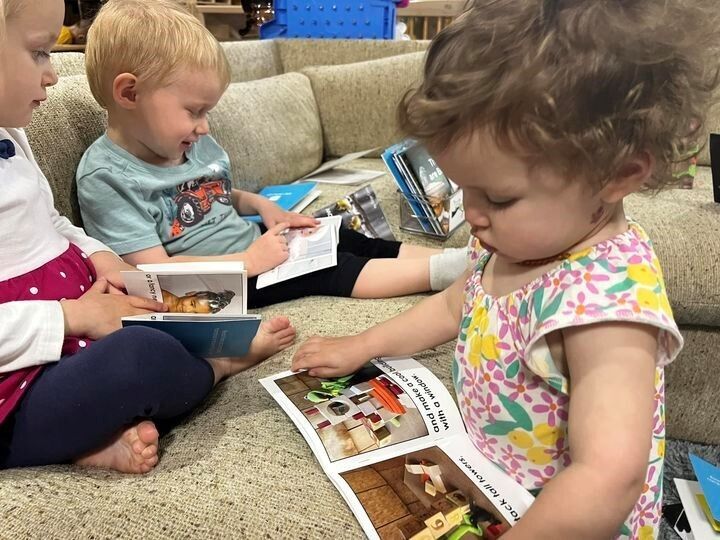
Both Kim Chase and Amy Standley agree on a very specific detail about Nebraska Growing Readers (NGR) books: they fit well in small hands. While this may seem minor, it means that the children these early childhood professionals work with are holding the books, looking at the colorful pictures, identifying what they see; such moments are the early literacy moments NGR strives for.
But the small size of the books has an even more special meaning to Standley, who works for Educare Lincoln. She is able to fit several easily into her bag, which she takes home where her son eagerly looks to see if the books are there. Standley’s youngest son is non-verbal, and she says of the books, “my son is the same age as the kids I teach and he responds so well to them.” She describes how he holds them in his little hands and how she feels there is no pressure for him to speak because the pictures tell their own story.
Standley describes the bonding moments of shared reading with her son: “Even though I don’t know exactly what his mind is thinking, I like to assume I can when we look at books together.” She adds that he carries the books all over the house, especially his favorite Are We There Yet, which includes pictures of cars and trucks. She says, “he’ll get his little trucks and he’ll get his book and he’ll hold them up together.” The connection he’s made between the object and the image is an important early moment of literacy.
NGR, which is a collaborative effort between Nebraska Children and Families Foundation, Nebraska Department of Education, the Statewide Family Engagement Center, and Unite for Literacy, promotes such shared-reading moments not only for their impact on literacy, but also for the connections they build.
Chase, who owns her home-based Chase’s Childcare Corner in Papillion, says her children are taking 4 or 5 books home every month. She makes the books a point of connection between families, reminding them of their children’s favorite NGR books and encouraging the parents to ask questions about those books. She says she also tells parents that the books are “a great opportunity for kindergarten and first-grade siblings to practice high frequency words by reading to their younger siblings.”
Parents have responded positively to the NGR program, telling Chase that because the books are short, they can read 4 or 5 books to the children in a night. In light of a 2019 research study done by Ohio State University’s Crane Center for Early Childhood Research and Policy that concluded “Young children whose parents read them five books a day enter kindergarten having heard about 1.4 million more words than kids who were never read to,” this is exciting and encouraging news.
Chase reports some early literacy moments similar to those that Standley detailed. She says she sees children who’ve heard the books read to them pointing to specific words and trying to identify them. She noticed that one young girl would point to a word or picture and say, “I like . . .” and then identify whatever was depicted. Though she knows the children aren’t technically reading and emphasizes that she doesn’t push children to read before they are ready, she says the books are “really promoting literacy from younger kids who aren’t technically reading, but have seen and heard the books enough that they understand.” She had a heartening moment recently when, during downtime, she watched an older infant and two toddlers pick books and sit together turning the pages and looking at the pictures.
While both women shared quiet moments such as these where children pulled NGR books off the shelves to look at on their own, they also said that the books were very useful as a group tool. Chase says that when she is shifting from an energetic activity to something quieter, she will often pick up one of the books and say, “I’m going to read books now if anyone wants to join me.” Lots of them do, she adds, and it acts as a nice transition. Standley says there are academic lessons on shapes, counting, and colors that she can use, but what she really likes are the social-emotional lessons the books offer. She says, “I want them to learn manners; I want them to learn about life; and these books are so good with those social-emotional moments.” As an example she says, “we went out to the garden today, and we used the garden book from the series.”
Standley also points out how diverse the children she works with are and how the books, “look like the kids I work with.” She showed one boy who just got glasses the book Who Wears Glasses, pointing out, “see, you look like these people.” She also said that her Spanish-speaking families were appreciative of the Spanish versions of the texts she could offer them. One parent told her it was nice the books acknowledge that they speak a different language. Standley recounted that at a recent event, an NGR staff member played the digital version of a book to a girl who spoke Ukrainian to her in her native language, and “her eyes just lit up.”
Chase and Standley make clear that literacy is not just about reading; it’s about bonding over books--in the classroom and at home, between family members, with providers, and among peers. To prove the point, Standley says that when her oldest son comes home from UNO, he and her non-verbal son pick up an NGR book and read. Maybe that is why she says of the books, “I love them. They are so special to me.” And why NGR promotes not just the adoption of reading, but the adoption of shared reading.

